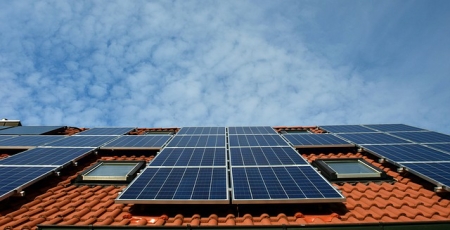VAT hike puts brakes on home solar and batteries

|
On Monday June 24, less than two weeks after outgoing Prime Minster Theresa May declared that the UK will achieve its new ‘Net Zero Carbon’ goal by 2050, a jubilant renewable energy industry was quickly pulled back down to earth. HMRC announced that, from October 1, 2019, VAT on home solar PV and solar-battery systems will increase sharply from 5% to 20%.
The PM’s net zero announcement positioned the UK as a world leader in the fight against climate change. This latest move, however, somewhat contradicts that commitment. It could also further destabilise the UK’s renewable energy industry, which was left wounded by the recent removal of the Feed-in Tariff.
Our net zero commitment still stands, of course, and it is still expected to herald more de-centralised renewable energy installations and accelerate the electrification of infrastructure, but the transition to a carbon-free future will be hampered by this VAT hike.
The labour component of solar and battery installations – the cheapest part – will remain taxed at 5%. The new rate will apply to material costs, which in general are the most expensive part of an installation. This will most likely have a negative effect on a key part of the energy mix needed to balance the grid and enable more ‘self-consumption’ by members of the public. Meanwhile (and worryingly for our net zero target), VAT rates for home gas and coal supplies will remain at 5%.
It is disappointing that, despite clear and definitive guidance from the Committee on Climate Change, and overwhelming consensus in the scientific community (and in the general population), the government still went ahead with this decision.
The official rationale is that, according to EU law ruled in 2015, the discounted tax rate was illegal to begin with. However, the government did not enact any changes to the VAT rate at the time, and the European Court of Justice has since published a VAT action plan (2016) without comment on solar power. It is perhaps telling that the new rates are due to come into effect the same month that the UK is to leave the EU.
ECA will continue to encourage government to make it clear how it intends to support industry in making the shift to a carbon-free future, and will continue to recommend actions that work for the benefit of both business and the environment.
[edit] About this article
This article was written by Luke Osborne, ECA Energy and Emerging Technologies Solutions Advisor. It was previously published on the website of the ECA in June 2019 and can be accessed here.
[edit] Related articles on Designing Buildings Wiki
- Battery energy storage systems with grid-connected solar photovoltaics BR 514.
- BRE National Solar Centre.
- BRE photovoltaic certification scheme.
- Code of practice for grid connected solar photovoltaic systems.
- Future of electricity in domestic buildings.
- Installation of photovoltaic panels on existing flat roofs - some lessons learned IP 8 14.
- Large scale solar thermal energy.
- Microgeneration.
- Micro-grid.
- Renewable energy sources: how they work and what they deliver: Part 4: Solar thermal hot water systems DG 532 4.
- Solar Squared.
- Solar thermal systems.
- Tau - the solar powered island.
- Wind loads on roof-mounted photovoltaic and solar thermal systems DG 489.
--ECA
Featured articles and news
RTPI leader to become new CIOB Chief Executive Officer
Dr Victoria Hills MRTPI, FICE to take over after Caroline Gumble’s departure.
Social and affordable housing, a long term plan for delivery
The “Delivering a Decade of Renewal for Social and Affordable Housing” strategy sets out future path.
A change to adoptive architecture
Effects of global weather warming on architectural detailing, material choice and human interaction.
The proposed publicly owned and backed subsidiary of Homes England, to facilitate new homes.
How big is the problem and what can we do to mitigate the effects?
Overheating guidance and tools for building designers
A number of cool guides to help with the heat.
The UK's Modern Industrial Strategy: A 10 year plan
Previous consultation criticism, current key elements and general support with some persisting reservations.
Building Safety Regulator reforms
New roles, new staff and a new fast track service pave the way for a single construction regulator.
Architectural Technologist CPDs and Communications
CIAT CPD… and how you can do it!
Cooling centres and cool spaces
Managing extreme heat in cities by directing the public to places for heat stress relief and water sources.
Winter gardens: A brief history and warm variations
Extending the season with glass in different forms and terms.
Restoring Great Yarmouth's Winter Gardens
Transforming one of the least sustainable constructions imaginable.
Construction Skills Mission Board launch sector drive
Newly formed government and industry collaboration set strategy for recruiting an additional 100,000 construction workers a year.
New Architects Code comes into effect in September 2025
ARB Architects Code of Conduct and Practice available with ongoing consultation regarding guidance.
Welsh Skills Body (Medr) launches ambitious plan
The new skills body brings together funding and regulation of tertiary education and research for the devolved nation.
Paul Gandy FCIOB announced as next CIOB President
Former Tilbury Douglas CEO takes helm.
UK Infrastructure: A 10 Year Strategy. In brief with reactions
With the National Infrastructure and Service Transformation Authority (NISTA).























